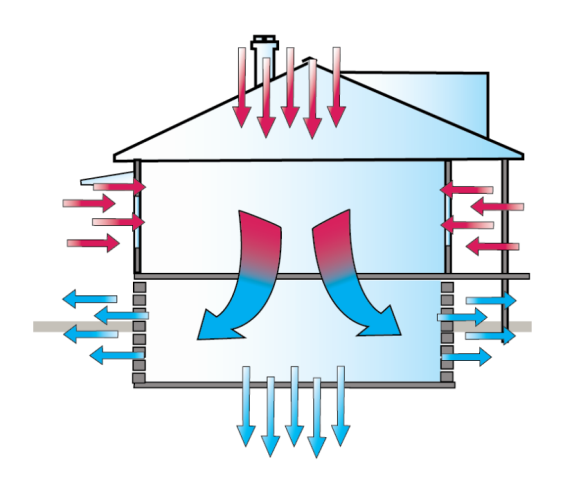To understand the stack effect, you must one basic rule: warm is lighter than cold air.
The stack effect is most common during the winter and the summer. It refers to when warm air moves upwards in the house and cold area settles at the lower levels.
Winter is the most common time you will experience the stack effect. This is because in the winter months the indoor-outdoor temperature is great. Cold air is dense and heavy while warm air is light. during the winter when the winter when the indoor air is warmer than the outdoor air, therefore it raises to the upper levels of the house and escapes through the windows, vents or cracks in the building.
Once the warm rise and get out of the house, this reduces the pressure in the base of the building. This, in turn, forces the cold air from outside to infiltrate through any openings in the house. They could be open doors, windows, and vents.
The stack effect in generally causes cold air infiltration at the lower part of the house and exfiltration on the upper floors.
The stack effect is a simple explanation of why you need to ensure your home is air sealed.

Is there an appliance that can affect the air pressure in the house?
Mechanical equipment like clothes dryers, built in vacuum cleaners, dust collection systems, bathroom exhaust fans and range hoods, can cause negative pressure.
Negative pressure happens when too much air is pumped out of the house than what is induced through the available ventilation spaces. All exhaust air from a building contributes to negative pressure inside the building. If the house is air sealed this negative pressure can greatly affect the structural integrity of the house.
In the summer the stack effect is reversed, since air outside is warmer and rising, while most home with air conditionals which make the indoor air mass fall. This means that most of the air in the house is cooler than the warm air outside.
This cause a total reverse of the stack effect where most of the air is cold air house air exfiltration at the lower floors and warm air infiltration through upper floors. Thus the greater air pressure is experienced at the lower floors or in the basement.
air infiltration in the home is caused by the stack effect, wind and mechanical equipment.
What are the effects of stack effect?
The stack effect basically allows air from the lower floor to move up to the upper floors. Here are some of the negative impacts of the stack effect :
- High humidity – a house with a basement or a crawl space, is known to have increased levels of humidity in this space. Through the stack effect, the high humidity is able to move from the basement into other rooms in the house. High humidity causes damage to the house and any items in the rooms.
- Poor indoor air quality – damp basement air is able to find its way to the rest of the house. This can make the home very uncomfortable for the occupants. Mold spores and mildew are able to spread from the basement or the crawl space. This can cause Eye irritation, A stuffy nose, Allergies, Wheezing or sneezing when in the house constantly, Respiratory problems like asthma, Constant recurring headaches, and Indoor discomfort.
- Mold growth - once the high humidity is able to move into other room and condense on the walls and on items, it greats the perfect environment for mold to grow.
- Damage to property - when the high humidity is able to move to all the rooms in the house this cause a lot of moisture damage in the rooms. This cause an increase in the cost of the house maintenance.
- Pest infestation – pest are known to like warm moisture environments if the humidity is able to get to other rooms in the house. This will attract the pest move to all rooms in the house.
























Leave a comment
All comments are moderated before being published.
This site is protected by hCaptcha and the hCaptcha Privacy Policy and Terms of Service apply.